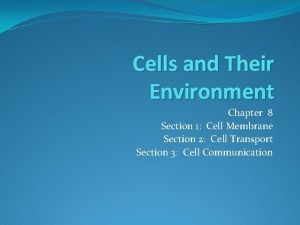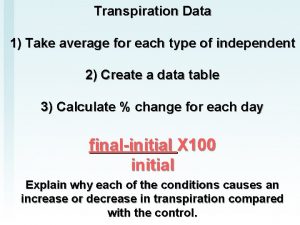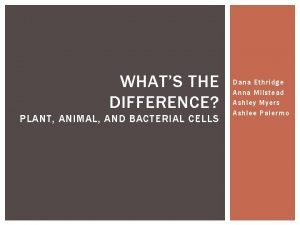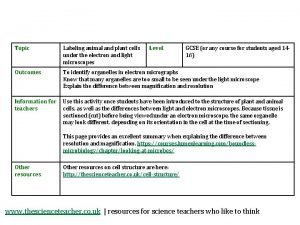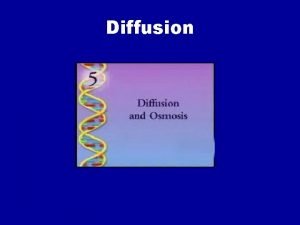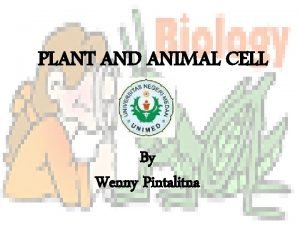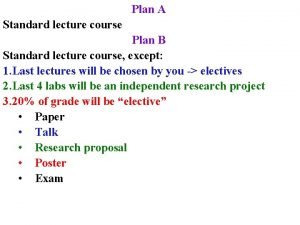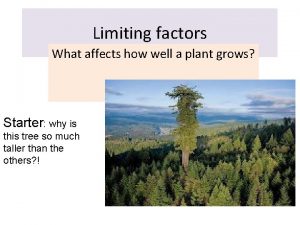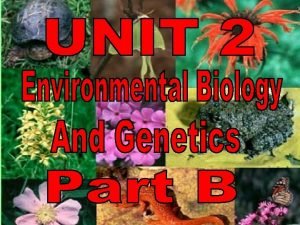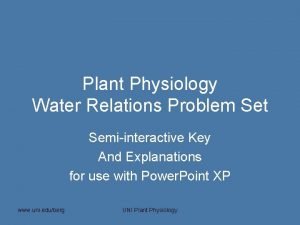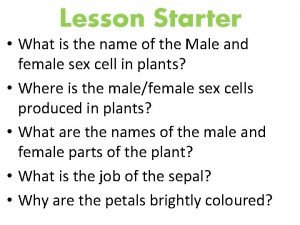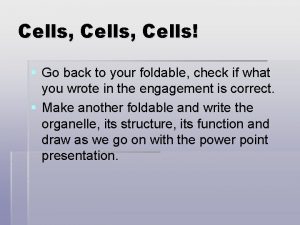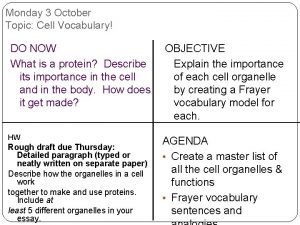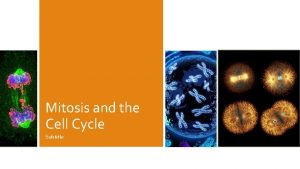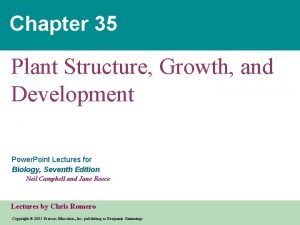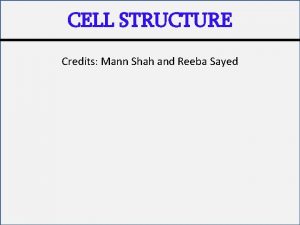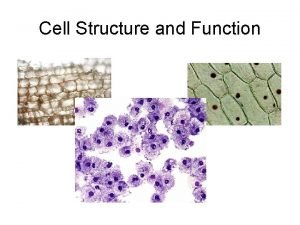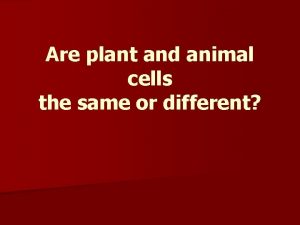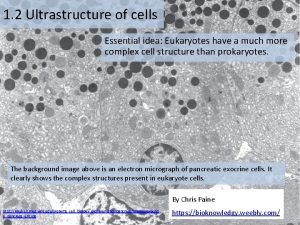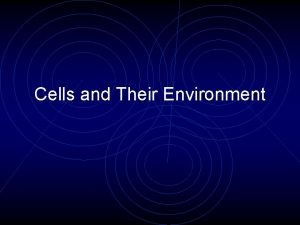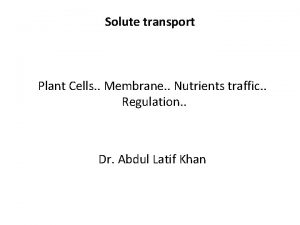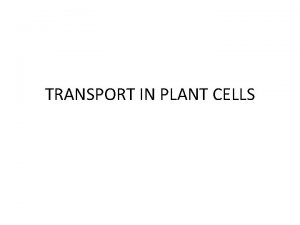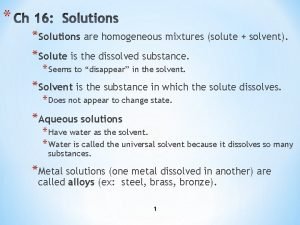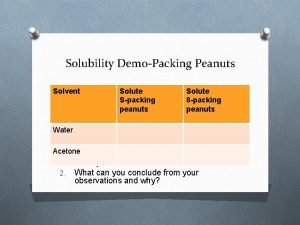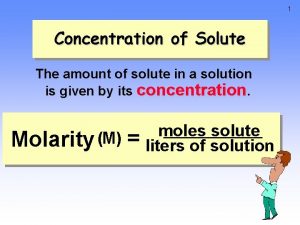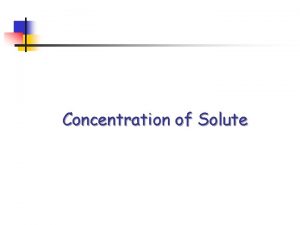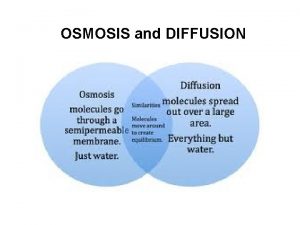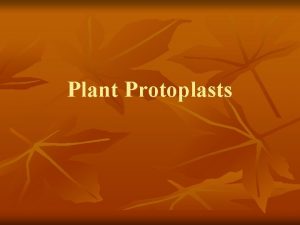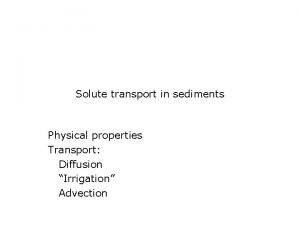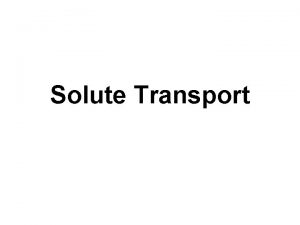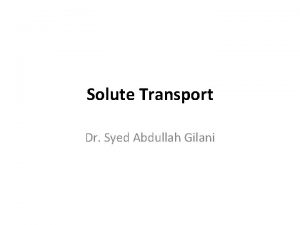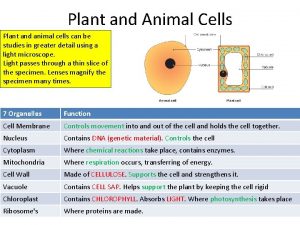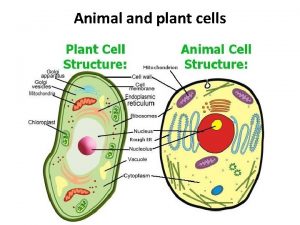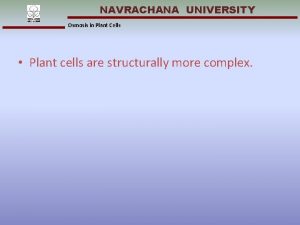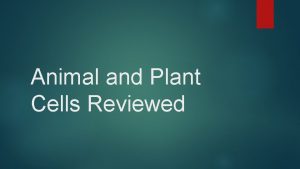Solute transport Plant cells separated from their environment
















































- Slides: 48

Solute transport • Plant cells separated from their environment by a thin plasma membrane (and the cell wall) • Must facilitate and continuously regulate the inward and outward traffic of selected molecules and ions as the cell – Takes up nutrients – Exports wastes – Regulates turgor pressure – Send chemical signals to other cells

Two perspectives for membrane transport • Cellular level – Contribution to cellular functions – Contribution to ion homeostasis (i. e. , balance) • Whole-plant level – Contribution to water relations – Contribution to mineral nutrition – Contribution to growth and development

Moving into cells and between compartments requires membrane to be crossed • Composed of a phospholipid (Lipid+Phosphate group) bilayer and proteins. • The phospholipid sets up the bilayer structure • Phospholipids have hydrophilic heads and fatty acid tails. • Such organization makes plasma membrane selectively permeable to ions and molecules.

Passive transport: The spontaneous downhill movement of molecules down a gradient of free energy or chemical potential is called passive transport. At equilibrium no further movements of solute can occur without the application of driving force Active transport: The movement of substances against or up a gradient of chemical potential is termed as active transport. It is not spontaneous and it requires that work be done on the system by application of cellular energy (one way may be by coupling transport to ATP hydrolysis) The importance of the concept of chemical potential is that it sums all the forces that may act on a molecule to drive net transport

Passive and active transport If we have semipermeable membrane separating two aqueous compartments, and add to one of them a solute that can pass readily across the membrane, the solute will starts to move from the higher concentration compartment across membrane (down gradient) to the other compartment until we reach equilibrium. n. At this point the rate of transfer of solute from the first compartment to the second exactly counterbalanced by the transfer of solute in the opposite direction. n


Simple diffusion • Molecules and ions move spontaneously down their concentration gradient (i. e. , from a region of higher to a region of lower concentration) by simple diffusion.

Facilitated diffusion • Facilitated diffusion of ions takes place through proteins, or assemblies of proteins, embedded in the plasma membrane. These trans-membrane proteins form a water-filled channel through which the ion can pass down its concentration gradient. • The trans-membrane channels that permit facilitated diffusion can be opened or closed. They are said to be" gated. "


• All molecules and ions are in constant motion and it is the energy of motion kinetic energy that drives passive transport.


Active transport • Is the movement of solute against or up a concentration gradient. i. e from a compartment of low concentration to a compartment of high concentration. • Entropy will decrease (the solute become less random) and the free energy of the system will increase. • Active transport is a process in which the system gains free energy.

Active transport • Active transport is the pumping of molecules or ions through a membrane against their concentration gradient. It requires : A transmembrane protein (Ion Pump). Energy in the form of ATP.

Two problems to be considered : 1 - Relative concentrations. 2 - Lipid bilayers which are impermeable to most essential molecules and ions. 1. Relative conc: Molecules and ions can be moved against their concentration gradient, so this process requires the expenditure of energy (usually from ATP). 2 - The impermeable lipid bilayer The lipid bilayer is permeable to water molecules and a few other small, uncharged, molecules like oxygen and carbon dioxide. These diffuse freely in and out of the cell. The diffusion of water through the plasma membrane is of such importance to the cell that it is given a special name: osmosis.

Membrane potential • Membrane potential is the difference in electrical potential between the interior and the exterior of a biological cell • Arise because charged solutes cross membranes at different rates • Create a driving force for ionic transport • KCl Solution example • K+ and Cl- ions diffuse at different rates across the membranes • Membranes are more permeable to K+ than to Cl • Initially diffuse at different rates unless they achieve equilibrium Potential as a result of diffusion

Diffusion potential: K+ will diffuse out of the cell faster than Cl causing the cell a negative charge with respect to the medium. A potential that develops as a result of diffusion is called diffusion potential Electrical neutrality: Electrical neutrality is preserved in KCl diffusion across membranes because K+ moves ahead of Cl in the membrane, the resulting diffusion potential retards the movement of of K+ and speeds that of Cl. Ultimately both ions diffuse at the same rates, but the diffusion potential persists and can be measured. As the system moves towards equilibrium and the conc gradient collapses, the diffusion potential also collapses However if the membrane is permeable to only K+, diffusion of K+ would carry charge across the membrane until membrane potential balanced the concentration gradient. Because a change in potential requires very few ions, this balance would be reached instantly. Potassium ions would then be at euilibrium even though the change in conc gradient for K+ would be negligible. All living cells exhibit a membrane potential that is due to the asymmetric ion distribution between the inside and outside of the cell, which can be measured by inserting a microelectrode inside a cell and measuring the voltage difference between inside cell and outside bathing medium

Ion homeostasis within plant cells • Plant cells segregate ions based upon: – Function or role – Potential toxicity • This segregation creates a balance • Creating and maintaining the balance may require energy • Potassium is accumulated passively by both the cytosol and vacuole. When extracellular conc is very low K+ may be taken up actively • Na is pumped actively out of cytosol into the extracellular space & vacuole • Excess H+ generated by intermediary metabolism are actively extruded from the cytosol. This process maintains the cytosolic p. H near neutral while vacuole and outside medium are acidic by one or two p. H units • Anions are taken up actively into cytosol • Calcium is actively transported out of cytosol at both the cell membrane and tonoplast

Electrogenic pumps and membrane potential • Electrogenic pumps are ATPases (enzymes that split ATP) • ATPases use ATP energy to “pump” out protons (H+) to create charge gradients • H+ gradients create a type of “battery” to power transport and maintain ion homeostasis

Electrogenic pumps and membrane potential • To prove this • Add cyanide (CN) – Rapidly poisons mitochondria, so cells ATP is depleted – Membrane potential falls to levels seen with diffusion • So membrane potential has too parts – Diffusion – Electrogenic ion transport • Requires energy

Ion homeostasis within plant cells • Plant cells segregate ions based upon: – Function or role – Potential toxicity • This segregation creates a balance • Creating and maintaining the balance may require energy

Ion homeostasis within plant cells • Ion concentrations in cytosol and vacuole are controlled by passive (dashed) and active (solid) transport processes • In most plant cells vacuole takes up 90% of the cell volume – Contains bulk of cells solutes • Control of cytosol ion concs is important for the regulations of enzyme activity • Cell wall is not a permeability barrier – It is NOT a factor in solute transport

Passive vs active transport • Passive or active transport depends on the gradient in electrochemical potential • The electrochemical potential has 2 parts – Concentration – Charge (Electrical) • The two parts together dictate the electrochemical potential for a compartment of a cell

Passive v. active transport • Passive transport – Movement down the electrochemical gradient – From a more positive electrochemical potential – to a more negative electrochemical potential • Active transport – Movement against electrochemical gradient – From a more negative electrochemical potential – to a more positive electrochemical potential

Electrochemical potential versus water potential • Just like water potential, solutes alone must follow the rules of the electrochemical potential and move passively • If this is not what the cell or plant tissue needs, two components are required somewhere to counteract this natural tendency – Energy – Membrane transport proteins

Membrane transport • Facilitate the passage of ions and other polar molecules • Arabidopsis thaliana contains 849 membrane proteins (4. 8% of genome) • Three types of membrane transporters enhance the movement of solutes across plant cell membranes – Channels – passive transport – Carriers – passive/active transport – Pumps- active transport

Simple diffusion • Movement down the gradient in electrochemical potential • Movement between phospholipid bilayer components • Bidirectional if gradient changes • Slow process

Channels • Transmembrane proteins that work as selective pores – Transport through these passive • The size of the pore determines its transport specifity • Movement down the gradient in electrochemical potential • Unidirectional • Very fast transport • Limited to ions and water

The channels are not open all the time but are ‘gated’. The gates open or close in response to external stimuli that include, (i) voltage changes, (ii) light, (iii) hormone binding and (iv) ions themselves. When gates are open, the ions can diffuse through the chan nels but not when they are closed. The channel proteins are believed to contain a sensing region or sensor which responds to the appropriate stimulus by changing conformation of channel protein opening the gate.

Channels • Sometimes channel transport involves transient binding of the solute to the channel protein • Channel proteins have structures called gates. – Open and close pore in response to signals • Light • Hormone binding K+ form the environment, opening of stomata • Only potassium can diffuse either inward or outward – All others must be expelled by active transport. Release of K+ into xylem Closing of stomata

Those channels which allow inward transport of ions (i. e. , towards cytosol side), are called as inward rectifying or inward channels and those which allows outward diffusion (i. e. , from cytosol to other side) are called as outward rectifying or outward channels. Ca 2+ channels are inward rectifying while anion channels are always outward, (for transport of such ions in reverse direction, active transport mechanisms are required) K+ is exceptional. It can diffuse inward or outward across the membrane through chan nels depending upon more negative or more positive membrane potential respectively. . Many channel proteins are inducible i. e. , they are synthesized by the cell when a par ticular solute is available for absorption.

Remember the aquaporin channel protein? • There is some diffusion of water directly across the bilipid membrane. • Aquaporins: Integral membrane proteins that form water selective channels – allows water to diffuse faster – Facilitates water movement in plants • Alters the rate of water flow across the plant cell membrane – NOT direction

Carriers • Do not have pores that extend completely across membrane • Substance being transported is initially bound to a specific site on the carrier protein – Carriers are specialized to carry a specific organic compound • Binding of a molecule causes the carrier protein to change shape – This exposes the molecule to the solution on the other side of the membrane • Transport complete after dissociation of molecule and carrier protein

• Moderate speed Carriers – Slower than in a channel – 100 -1000 ions or molecules/second • Binding to carrier protein is like enzyme binding site action • Can be either active or passive • Passive action is sometimes called facilitated diffusion • Unidirectional

Active transport • To carry out active transport: – The membrane transporter must couple the uphill transport of a molecule with an energy releasing event • This is called Primary active transport – Energy source can be • The electron transport chain of mitochondria • The electron transport chain of chloroplasts • Absorption of light by the membrane transporter • Such membrane transporters are called PUMPS

Primary active transport. Pumps • Movement against the electrochemical gradient • Unidirectional • Very slow • Significant interaction with solute • Direct energy expenditure

pump-mediated transport against the gradient (secondary active transport) • Involves the coupling of the uphill transport of a molecule with the downhill transport of another • (A) the initial conformation allows a proton from outside to bind to pump protein • (B) Proton binding alters the shape of the protein to allow the molecule [S] to bind

pump-mediated transport against the gradient (secondary active transport) • (C) The binding of the molecule [S] again alters the shape of the pump protein. This exposes the both binding sites, and the proton and molecule [S] to the inside of the cell • (D) This release restores both pump proteins to their original conformation and the cycle begins again

pump-mediated transport against the gradient (secondary active transport) • Two types: • (A) Symport: – Both substances move in the same direction across membrane • (B) Antiport: – Coupled transport in which the downhill movement of a proton drives the active (uphill) movement of a molecule – In both cases this is against the concentration gradient of the molecule (active)

pump-mediated transport against the gradient (secondary active transport) • The proton gradient required for secondary active transport is provided by the activity of the electrogenic pumps • Membrane potential contributes to secondary active transport • Passive transport with respect to H+ (proton)

Overview of Ion homeostasis in plant cells

The Vacuole • Can be 80 – 90% of the plant cell • Contained within a vacuolar membrane (Tonoplast) • Contains: – Water, inorganic ions, organic acids, sugars, enzymes, and secondary metabolites. • Required for plant cell enlargement • The turgor pressure generated by vacuoles provides the structural rigidity needed to keep herbaceous plants upright.

The Vacuole In general, the functions of the vacuole include: • Isolating materials that might be harmful or a threat to the cell • Containing waste products • Containing water in plant cells • Maintaining internal hydrostatic pressure or turgor within the cell • Maintaining an acidic internal p. H • Containing small molecules • Exporting unwanted substances from the cell • Allows plants to support structures such as leaves and flowers due to the pressure of the central vacuole • In seeds, stored proteins needed for germination are kept in 'protein bodies', which are modified vacuole

Ion homeostasis in plant cells • Tonoplast antiporters move sugars, ions and contaminants to the cytoplasm from the vacuole • Anion channels maintain charge balance between the cytoplasm and vacuole • Ca channels work to control second messenger levels & cell signaling paths between vacuole and cytoplasm

Plasma membrane transporters

Plasma membrane transporters

Ion transport in roots • As all plant cells are surrounded by a cell wall, Ions can be carried through the cell wall space with out entering an actual cell – The apoplast • Just as the cell walls form a continuous space, so do the cytoplasms of neighboring cells – The symplast

Ion transport in roots • All plant cells are connected by plasmodesmata. • In tissues where large amounts of intercellular transport occurs neighboring cells have large numbers of these. – As in cells of the root tip • Ion absorption in the root is more pronounced in the root hair zone than other parts of the root. • An Ion can either enter the root apoplast or symplast but is finally forced into the symplast by the casparian strip.

Ion transport in roots • Once the Ion is in the symplast of the root it must exit the symplast and enter the xylem – Called Xylem Loading. • Ions are taken up into the root by an active transport process • Ions are transported into the xylem by passive diffusion
 Venn diagram for animal and plant cells
Venn diagram for animal and plant cells Cells and their environment worksheet answers
Cells and their environment worksheet answers Estimate the solute concentration of the zucchini cells
Estimate the solute concentration of the zucchini cells Pns water view position
Pns water view position Transport maximum
Transport maximum Pineal gland
Pineal gland How are mitosis and meiosis similar
How are mitosis and meiosis similar Somatic vs germ cells
Somatic vs germ cells Chlorocruorin
Chlorocruorin Eukaryotic cells vs prokaryotic cells
Eukaryotic cells vs prokaryotic cells Prokaryotic cells vs eukaryotic cells venn diagram
Prokaryotic cells vs eukaryotic cells venn diagram The organelle trail
The organelle trail Masses of cells form and steal nutrients from healthy cells
Masses of cells form and steal nutrients from healthy cells Younger cells cuboidal older cells flattened
Younger cells cuboidal older cells flattened Prokaryotic cells vs eukaryotic cells
Prokaryotic cells vs eukaryotic cells Are red blood cells prokaryotic
Are red blood cells prokaryotic Chapter 8 cellular reproduction cells from cells
Chapter 8 cellular reproduction cells from cells Cells cells they're made of organelles meme
Cells cells they're made of organelles meme Antiporters
Antiporters Primary active transport and secondary active transport
Primary active transport and secondary active transport Now answer the following questions
Now answer the following questions Active vs passive transport venn diagram
Active vs passive transport venn diagram Unlike passive transport active transport requires
Unlike passive transport active transport requires Primary active transport vs secondary active transport
Primary active transport vs secondary active transport Bioflix activity membrane transport active transport
Bioflix activity membrane transport active transport Active transport image
Active transport image Bioflix activity membrane transport diffusion
Bioflix activity membrane transport diffusion Whats the difference between animal and plant cells
Whats the difference between animal and plant cells Animal cell under microscope
Animal cell under microscope Animal and plant cell venn diagram
Animal and plant cell venn diagram Transport mechanism
Transport mechanism What cell type
What cell type Structure of a plant cell
Structure of a plant cell Perixomes
Perixomes ро
ро Limiting factor
Limiting factor Whats the difference between plant and animal cells
Whats the difference between plant and animal cells Group of multicellular oxygen producers
Group of multicellular oxygen producers Gametes
Gametes Water relations in plant cells worksheet answers
Water relations in plant cells worksheet answers Plant sex cells
Plant sex cells Cell theory foldable
Cell theory foldable Plant vs animal cells
Plant vs animal cells Microtubules in plant cells
Microtubules in plant cells Plant structure growth and development
Plant structure growth and development Microvilli in plant cells
Microvilli in plant cells Plant cells
Plant cells Whats the difference between plant and animal cells
Whats the difference between plant and animal cells Palisade mesophyll cell function
Palisade mesophyll cell function

